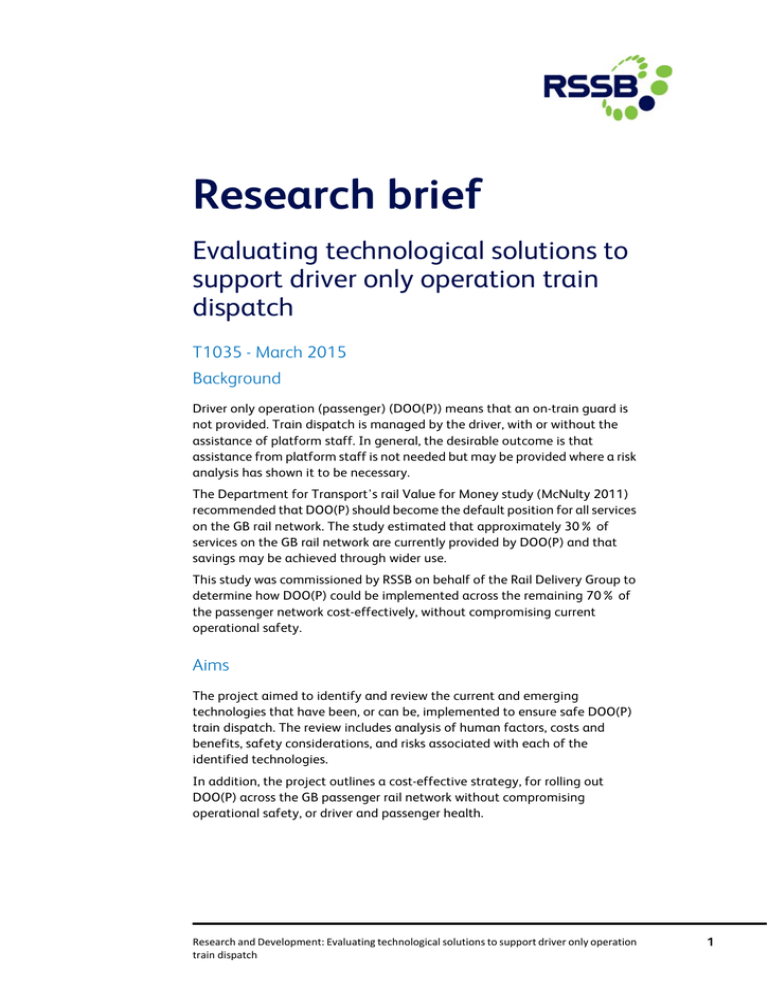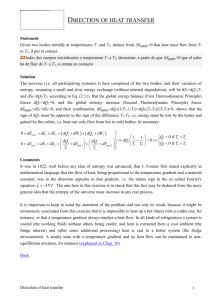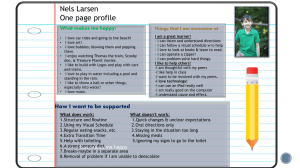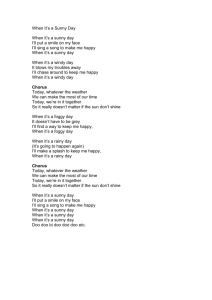Research brief Evaluating technological solutions to support driver only operation train dispatch
advertisement

Research brief Evaluating technological solutions to support driver only operation train dispatch T1035 - March 2015 Background Driver only operation (passenger) (DOO(P)) means that an on-train guard is not provided. Train dispatch is managed by the driver, with or without the assistance of platform staff. In general, the desirable outcome is that assistance from platform staff is not needed but may be provided where a risk analysis has shown it to be necessary. The Department for Transport's rail Value for Money study (McNulty 2011) recommended that DOO(P) should become the default position for all services on the GB rail network. The study estimated that approximately 30% of services on the GB rail network are currently provided by DOO(P) and that savings may be achieved through wider use. This study was commissioned by RSSB on behalf of the Rail Delivery Group to determine how DOO(P) could be implemented across the remaining 70% of the passenger network cost-effectively, without compromising current operational safety. Aims The project aimed to identify and review the current and emerging technologies that have been, or can be, implemented to ensure safe DOO(P) train dispatch. The review includes analysis of human factors, costs and benefits, safety considerations, and risks associated with each of the identified technologies. In addition, the project outlines a cost-effective strategy, for rolling out DOO(P) across the GB passenger rail network without compromising operational safety, or driver and passenger health. Research and Development: Evaluating technological solutions to support driver only operation train dispatch 1 Findings An outline strategy for the rollout of DOO(P) across the GB main line railway system was developed and includes: • All new franchises to include a requirement to offer DOO(P), separately costed • All new rolling stock to have selective door opening and correct side door enable specified and linked to door controls • All new station designs or refurbishments to be required to determine optimum arrangements for DOO(P) • The use of on-board rear-view mirrors to be investigated and trialled on suitable, low traffic routes with short trains • Rolling stock to be retained after 2020 to be identified and investigated for DOO(P) conversion with either rear-view mirrors or on-board CCTV • New technology to allow image comparison techniques to assist platform train interface monitoring to be investigated and trialled on stations and trains A review of the safety implications of DOO(P) indicated that there may be changes to the risk profile, in terms of the likelihood of events occurring, or the severity of their consequences. However, with the right technical and operational mitigations the analysis has considered the provision of DOO(P) to be safety neutral. Individual platform assessments are needed to identify the technologies, mitigations or remedial works appropriate for each site to reduce risks to as low as reasonably practicable. Ideally, the same technology should be implemented over an entire service pattern to minimise driver workload and the potential for human error or confusion. In practice this may not always be possible or cost-effective given the varying risk levels at each platform. On-board cameras with in-cab monitors will maximise reliability and consistency of image presentation. The most effective approach overall may be to phase in the use of on-board DOO(P) technologies, ensuring that all new vehicles are fully equipped. Ergonomic practicalities and potential costs mean retrofitting 'legacy' stock with in-cab monitors may not be practicable. Even if retrofitting is practicable, platform-mounted equipment may be a cheaper alternative, depending on how much equipment must be replicated at each stopping point. A simple 2 Research and Development: Evaluating technological solutions to support driver only operation train dispatch solution for short trains may be folding mirrors mounted outside cabs, together with appropriately located door controls. Reducing the risk of the undesired events depends on effective implementation of the primary and supplementary technologies and appropriate systems. This would include safety documentation, training, communication, reporting, and monitoring. Once implemented, the technologies, together with well-documented procedures for maintenance, daily and periodic checks, fault reporting, and emergency response, will be monitored and their performance measured to ensure continued safety of train dispatch. Each platform or route should have a contingency plan in case the technology fails, alternative stock has to be used temporarily, or visual coverage of the train is impaired. This will ensure business continuity with minimised disruption and dispatch delay. The overall business case for DOO(P) is that it can deliver economic benefits at the network level. However, the net present value (NPV) and payback periods of implementing DOO(P) are heavily dependent on the implementation strategy. Adopting a strategy of guard redundancies delivers the greatest economic benefit, while a strategy of staff turnover and redeployment of guards delivers a reduced but still positive NPV over a 20-year analysis period. At the franchise level, the business analysis shows significant variation in both NPV and payback period. This demonstrates the need for a strategic approach to the further rollout of DOO(P). Those franchises and routes that can deliver the greatest return on investment should be prioritised. The cost-benefit analysis allows for various increased costs in its sensitivity analysis. Total NPVs over 20 years can range from a negative NPV to a positive £2.1 billion dependent on the industry redeployment strategy determined. With franchises of the order of 7 to 10 years, train operating companies (TOC) have limited business incentives to introduce DOO(P) unless it is included and funded in franchise contracts. Exceptions occur where a network is relatively 'contained' as for example in the cases of Great Northern and C2C, or where new or refurbished stations along a route ensure good sightlines as on parts of ScotRail's Airdrie-Bathgate line. As stated the business case is dependent on the implementation strategy, however, those franchises that consistently demonstrate the most long-term benefit are for franchises in the following areas: Northern, South Western, West Midlands, Wales and Borders, Great Western, TransPennine and Cross Country. Research and Development: Evaluating technological solutions to support driver only operation train dispatch 3 Deliverables The report contains a detailed analysis of practice and requirements for further rollout of DOO(P). It includes human factors, technologies, and safety risk analysis; how technologies and platform safety assessments can mitigate risks; and a cost-benefit analysis to establish a business case. This will inform the Rail Delivery Group and the Department for Transport about the issues, costs, and options for franchise specification in rolling out DOO(P) across the remaining 70% of the rail network. It will be particularly valuable in clarifying the steps and timescales involved in specifying or equipping rolling stock, upgrading stations and adjusting staffing arrangements. Method Requirements for and issues associated with DOO(P) have been addressed by: • Literature review • Station observations at 9 stations • Consultation of TOCs as to their current practices and requirements resulting in 9 responses and 4 face-to-face interviews based on a questionnaire format • Consultation of rolling stock leasing companies and Network Rail as to their current provisions and plans • Approaching original equipment manufacturers to capture technology aspects, including information from Europe where available • Human factors analysis with station site visits to identify the variety and individuality of station platform configurations, and the consequently highly specific dispatch practices adopted by TOCs based on their platform risk assessments • Safety risk analysis, which developed a detailed breakdown of undesired events with their associated causes, potential outcomes and technology mitigations (provided as an appendix to the report) • Cost-benefit analysis, which made use of new information on equipment costs obtained from stakeholders plus existing data on fleet composition from an earlier study 4 Research and Development: Evaluating technological solutions to support driver only operation train dispatch Next Steps The findings are broadly compatible with those of earlier studies and support the long-term benefits of DOO(P). This study has firmed up conclusions and clarified the issues, risks and mitigations taking full account of the practical responsibilities, needs and capabilities of the TOCs. The recommendation is to prioritise those franchises yielding the greatest benefit, and that these should specify new or existing stock equipped with or designed to be upgradable with on-board DOO(P) cameras and monitors. DfT is considering DOO(P) as a preferred option within all new franchises being let. This research will help the various bid teams within the industry to formulate their plans in response to the ITT for those tenders including any changes to platform layouts that may be necessary. As such the research will be included (as originally intended) in the DOO(p) 'tool box' which also includes the Guidance Note from RSSB and the Risk Assessment work also completed by RSSB. Retro-fitting stock is seen as problematic by the TOCs, but may be an option for some services, whilst the use of platform equipment appears a relatively expensive option but might be required initially at platforms where poor sight lines cannot easily be improved. Contact For more information please contact: Professional Lead - Operations R&D Research and Development RSSB enquirydesk@rssb.co.uk Block 2 Angel Square 1 Torrens Street London EC1V 1NY Research and Development: Evaluating technological solutions to support driver only operation train dispatch 5





